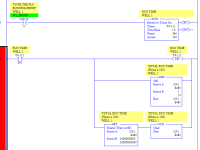Hi, I'm experienced in Studio 5000 / ControlLogix but have a small project to do in a Micro810 with CCW and something is driving me nuts. I want to store an accumulated time for a machine running so maintenance can look and see how many hours it has actually run for.
The idea was to grab the total ET from an RTO, add it to the T_Master_Count variable (TIME format) and then store that as a retained value (which weirdly only works on local variables, not globals as those get cleared out on every power-up regardless of "retained" setting being ticked in CCW) then if the PLC was powered up again, when running the machine it will continue adding the running ET to the T_Master_Count.
In a ControlLogix I would use MOV or COP to put the previous value of T_Master_Count into another temp variable, add the ET to that, and then MOV or COP it back to T_Master_Count. That way it doesnt rack up to crazy numbers by itself. The RTO doesn't store the ET between power down events, and machines get locked out for maintenance so the hour counter has to be stored for next time it wakes up.
In the Micro810 there is a MOV FB so I thought ok, I'll move the master count value to a temp variable and then add the RTO ET, using the _SYSVA_FIRST_SCAN on a ladder rung but it never executes - as if that bit never becomes true.
Am I missing something stupid? This would be so easy in Studio5000 but it seems to be annoyingly difficult to get it to work in CCW. Can't justify an L83 for example to count running time. The Micro810 is ideal as it has the LCD to display the hour count of the machine for the maintenance guys.
There must be an easy way to count elapsed time when a particular input is on, and then store that value when the input goes off. Next time it is on again, start adding to the value again so a cumulative total time value is stored. Maybe I'm getting tired but I just can't get this to work on the Micro810.
Can you do a one shot (ONS) on the 810? I can't find anything like it in the editor.
The idea was to grab the total ET from an RTO, add it to the T_Master_Count variable (TIME format) and then store that as a retained value (which weirdly only works on local variables, not globals as those get cleared out on every power-up regardless of "retained" setting being ticked in CCW) then if the PLC was powered up again, when running the machine it will continue adding the running ET to the T_Master_Count.
In a ControlLogix I would use MOV or COP to put the previous value of T_Master_Count into another temp variable, add the ET to that, and then MOV or COP it back to T_Master_Count. That way it doesnt rack up to crazy numbers by itself. The RTO doesn't store the ET between power down events, and machines get locked out for maintenance so the hour counter has to be stored for next time it wakes up.
In the Micro810 there is a MOV FB so I thought ok, I'll move the master count value to a temp variable and then add the RTO ET, using the _SYSVA_FIRST_SCAN on a ladder rung but it never executes - as if that bit never becomes true.
Am I missing something stupid? This would be so easy in Studio5000 but it seems to be annoyingly difficult to get it to work in CCW. Can't justify an L83 for example to count running time. The Micro810 is ideal as it has the LCD to display the hour count of the machine for the maintenance guys.
There must be an easy way to count elapsed time when a particular input is on, and then store that value when the input goes off. Next time it is on again, start adding to the value again so a cumulative total time value is stored. Maybe I'm getting tired but I just can't get this to work on the Micro810.
Can you do a one shot (ONS) on the 810? I can't find anything like it in the editor.






